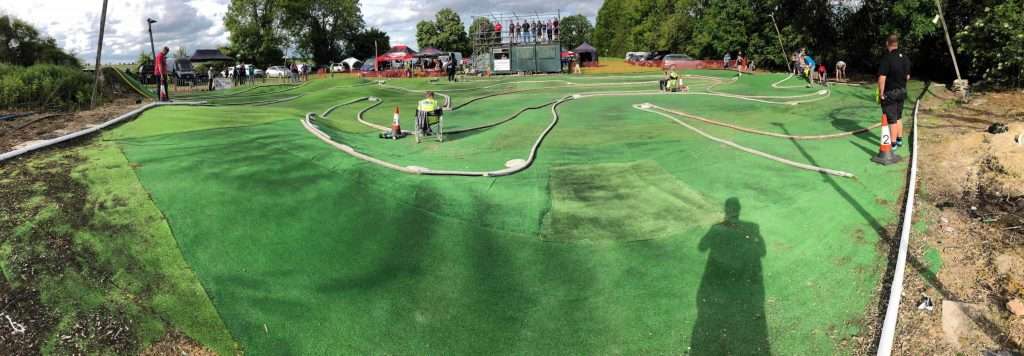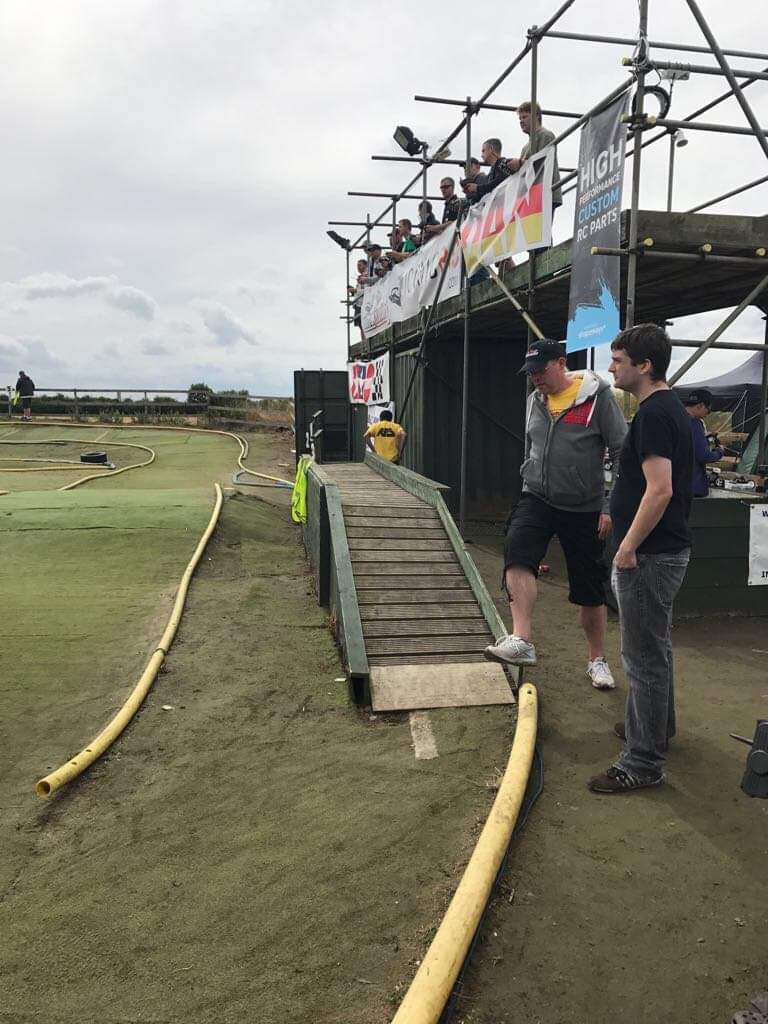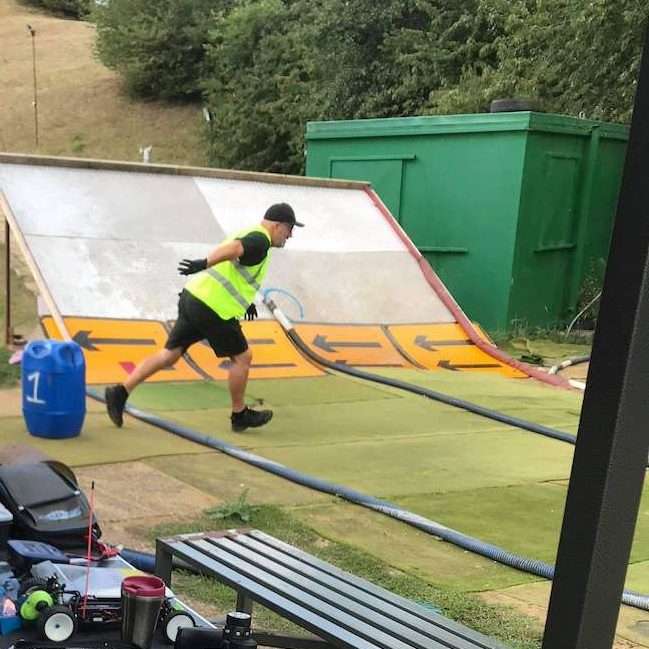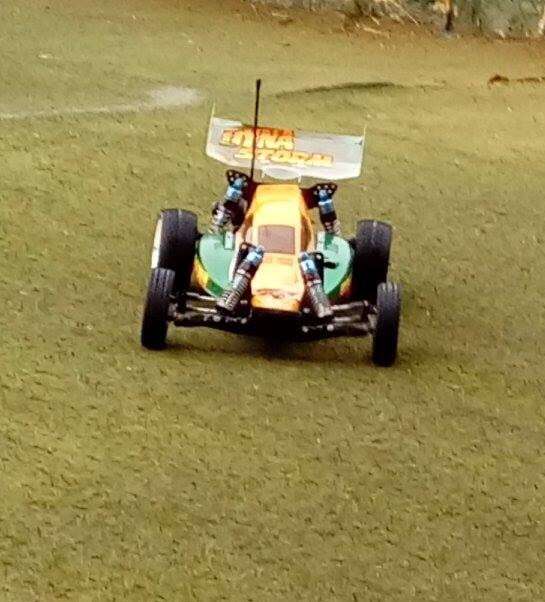
Welcome! This guide should give you a rough idea of what to expect at a club-level race meeting, and some tips to help first time racers.
The guide is based on my experience of a typical outdoor off-road meeting in the UK, so your experience might be slightly different depending on where you are in the world, the class of car you race, and the type of track, etc.
If you want to know what kind of racing gear you might need, check out this guide: get started in RC racing.
Arriving at the Race Meeting
A Typical daytime race meeting might start at 8:30am. For club racing, most tracks let you just turn up and race, but it is worth checking ahead just incase you need to prebook.
So once you arrive at the track, and after unloading your racing gear into the pit area, you’ll need to select a table to pit on (if not using your own). Get your charger set up and batteries on charge (unless of course you have charged them the night before) and unpack any tools and bits you might need for maintenance. Some clubs may ask that you use a pit mat or towel to protect pit tables. My preference is a pit towel because it helps prevent any screws or parts rolling away when carrying out car maintenance.
Practise before racing starts…
You’ll typically have an hour or so to use the track for practise before racing starts. Since you are new to racing, make the most of this time to get used to driving on a track.

Being completely new to RC car racing, you will find navigating around a narrow track is a lot more difficult than casual street bashing, and you’ll almost certainly have a few crashes. Don’t worry though, you will very quickly get used to it. Everyone has the odd crash now and again – even the very best racers. Take it slow and just get a feel for driving around a track.
Leave most car setup options alone for now…
Once you have put a few laps in, you’ll have an idea of how your car responds to the track. If you are running a car built from a professional kit (or a decent ready to run package), hopefully it has been set up according to the base (or kit) setup sheet. This will give a nice neutral feel and should work well for beginners and most tracks.
An incorrectly setup car (common when buying a preowned rc car) can drive with some very undesirable handling characteristics. If this seems like the case, try and reset all tuning adjustments back to base settings if you can, or get some advice from your fellow racers. Save playing with setup for when you have had some experience and are getting very consistent lap times.
Pro RC Cars usually drive really nicely on the base setup, and many casual racers don’t bother to deviate from this, with the exception of tires and ride height.
Half the fun of RC racing is tuning and adjusting the setup of your RC car to change the way it drives, but make sure you thoroughly understand what you are doing and why before going down this route.
Use the right tires for the track
For casual club racing you are usually free to use whatever tires you like, but if you get these very wrong it is only going to make driving more difficult for you as a beginner.
If you are struggling with traction and spinning out, or if you are constantly rolling the car when cornering due to too much grip (grip roll), try some different tires. Hopefully you’ll have a nice selection with you.
Ask other racers for advice; you’ll notice they’ll mostly be using the same tire because it works well on that particular track.
When you have a good feel for the track, and a bit more experience, you can look at making other changes to the car setup too, but for now, get very familiar with the stock or base setup first and experiment with tires.
Ride Height
Like Tires, ride height is another adjustment that will depend on the track. Understanding ride height will really help you as a beginner. Either use the stock setting or experiment to see what works, or ask other racers at the track what ride height setting they use.
Reducing ride height and stiffening the suspension will reduce body roll, lower the center of gravity and can help you take corners faster. However, this set up may be undesirable on a bumpy track or track with large jumps.
On a bumpy track you might want to increase ride height a little.
Booking in
At some point before racing starts, racers will be asked to book in. To book in, give your name, transponder number(s), and class or classes you intend to race to the race controller so that he can enter it into the race computer. Once all drivers are booked in, the race computer can generate the heat listings for the day. These are usually printed off and posted up on a display board.
Race fees are normally paid at this point.
Heat listings
With many racers, different classes, and the need for marshalls, races are divided up into groups called a Heat.
The race controller will use the timing software on the computer to generate heat listings for the day. Check the heat listings to see what race you are in.
The timing software on the race computer takes all booked in drivers and divides them into groups. If 40 people turn up, they can’t all race in the same race; the track would be too crowded, and there would be no marshalls to attend to any crashes on the track – and there will be crashes!
Some people will be driving 2wd, and some 4wd. These classes are broken up into groups too, although they can race together if there aren’t enough racers at the meeting.
Some clubs may also try to group drivers together based on ability.
Typically, the Heat listings will group racers together into a maximum of 10 cars per race, but this will depend on how busy the race meeting is.
Marshalling
If you flip your car, or crash and come flying off of the track, you’ll need to be marshalled. Racing wouldn’t be much fun if you all had to keep leaving the rostrum (racing stand) to go and flip your car back over after a crash; that’s why we have marshalls.

Most clubs don’t have the budget for employing a bunch of marshalls to turn flipped cars the right way up. So all racers are usually expected to marshall the next (or previous) race after their own.
Safe marshall points will be marked in various places around the track, and marshalls are usually the only people permitted on track while racing takes place.
Marshall points are often, but not always, marked with numbers. When they are present, your race number usually determines where you need to stand.
- Pay attention to the race in your zone or area when marshalling.
- Don’t be tempted to watch the leader all the way, as you will lose sight of your zone and miss any crashes that are close by.
- Don’t play with your phone!
- Get to the cars quickly, but safely. Keep an eye out for other drivers coming along your section and wait, if you have to, for them to pass.
- Always place the car back on the track in a safe position near to where it came off.
- Marshall how you would like to be marshalled!
Marshalling Damaged cars
Sometimes, if a car crashes, steering or suspension linkages can pop off the ball joints, or drive shaft / dog bones can fall out, etc. If you can pop the linkages or parts back on easily at the trackside, then the racer will certainly appreciate the chance to continue in the race. If the car needs more extensive repair work and unable to carry on, the car will usually be taken off the track, out of the way of other racers.
When Racing starts
As a guide, 10am is typical for a morning race meeting, but, of course, this will depend on the club.
A typical race meeting might consist of 3 qualifying rounds and a final, but again this all depends on the club and can be any number. My local club sometimes runs 4 qualifiers and 2 finals. If the meeting is very busy, we won’t run so many – we don’t want to be there all night!
Qualifiers
What are qualifiers?
Qualifiers are a way of sorting drivers ready for the Finals. Your qualifying position at the end will determine your starting position in the Finals.
You race against the clock, not other drivers, in qualifiers. The idea is to complete as many laps as you can in the best time. If you end up being Top Qualifier (TQ), you will start the finals in pole position, which is a great advantage.
The qualifiers typically last 5 minutes each, but this depends on the club. The cars’ numbers are called one by one so you are all going around the track spaced apart (although not for long – slower drivers will inevitably drop back and the experienced drivers will catch up and overtake).
It is courteous to let any faster, lapping cars pass, and, hopefully, drivers you are lapping will do the same.
Starting the race
Normally about 5 or 10 minutes before the first qualifier starts, the race controller will instruct any drivers that are in the first race – race 1 – to get ready.
As each race is run, an announcement will be made for the next one, and so on. So if you are in race 2, get your car ready while 1 is running. Once you have raced in race 2, go straight to marshalling race 3.
When your race number is finally called, you’ll need to get your car ready, battery in and powered up. Place it on the track and walk up to the rostrum with the transmitter. You’ll have a few minutes to get a quick practise lap or two in before the timer starts counting down, depending on how quickly you got everything ready.
Once you hear the automated race computer announcement of ’30 seconds until race starts’ depending on the system, finish your practise lap and head straight for the start line. Cars generally all sit together several yards back from the start line waiting for the beeps that indicate racing is about to start. The lower numbered cars need to be at the front of the group since they are about to go first. As racing starts, the computer will call ‘1,2,3,4, etc’ with spacing of a couple of seconds between. Soon as you hear your car number called, you can start.
In the first round, the cars are always called successively starting from car 1. In subsequent rounds, the starting order is determined by the results of the first round, and as each round progresses throughout the day, your starting position will change based on your overall qualifying position so far. Don’t worry though, the order for each round will be announced by the computer as each round starts, so listen carefully!
So once the countdown has finished and your car number is called, throttle up and off you go!
At regional and national race events you can win a trophy for being Top Qualifier, whether you win the Final or not.
How multiple qualifying rounds are calculated together
If there were only one qualifying round, then racers would be sorted by those who completed the highest number of laps in the least time.
With multiple qualifying rounds, things get a little more complicated. Results can be calculated based on the FTQ or Round by Round Methods.
FTQ – Fastest Time Qualifying
FTQ qualifying takes your very best qualifying round all day and uses that one for the final calculation.
It doesn’t matter how bad you did in any of the other rounds, as long as you got that one good run. But what if you had a really poor first round, and then it suddenly rained and the track was wet for the rest of the day? You’d have trouble rectifying your poor first round performance because the wet weather meant a much slower pace for the rest of the day. Those that beat your time in the first round would have a very unfair advantage.
Maybe this is the reason Round by Round Qualifying is more common at clubs (in the UK at least).
Round By Round Qualifying
When using the Round by Round system, the race computer software is configured with the number of rounds in total to be run, and the number of rounds that can count towards your final score.
Take this example:
Four qualifying rounds are going to be run, with the best two to count towards your score. So if your results for each round were as follows:
| Round | 1 | 2 | 3 | 4 |
|---|---|---|---|---|
| Best position | 4 | 15 | 9 | 11 |
Your best rounds were round one (position 4) and round three (position 9) 4+9=13. So your score for qualifying is 13 overall (lower number the better).
This system seems a bit fairer. If you had a nice dry track for the first round but a disappointing result, and then it rained for the rest of the day, you could still redeem yourself.
The final result is made up from the position of each round, not the best time as with FTQ. So if it rains, everyone has to deal with that rain and can not rely on a good run in the dry round earlier on.
If there is a draw between racers, it then comes down to the times of the two rounds.
Once qualifiers are all finished, you’ll have a break before the Finals begin. The Qualifying results, shortly followed by the Final listings, will be posted to the board showing your qualifying position and where you will start in the finals.

Finals
The finals are very straight forward. This is a race! Simply come first to win.
Line your car up on the grid on the correct number and wait for the countdown and starting tone from the Race computer. Check the final listings posted up on the board for your starting position.
The finals can be very entertaining, especially in off-road. All 10 cars going at once, very closely spaced, fighting to get in front. The middle cars often end up in a pile up on the first corner. If you are near the back, you can usually wait for this to happen, and drive around the carnage and carry on, quickly jumping ahead of 5 or so cars. It’s a lot of fun to watch!
The Top Qualifier is always car 1 on pole position, followed by everyone else in order of their qualifying position.
When there are too many drivers to fit into one Final for the class, they are broken up into groups (typically consisting of 10 drivers in each). So you’ll have an A Final, a B Final, a C Final, etc. with the best performing drivers in the A.
You can also have multiple Finals – Leg1, Leg2, etc. The results of each one are added together, just like Round by Round Qualifying. Times are used when there is a draw.
So that’s how it works. Once the finals are done, everyone usually rushes home to get back to their families.
What’s next?
Once you have some racing experience, you might want to learn about set up changes and tuning of your RC car. Check out these other guides I wrote…
Beginners Guide to RC Car Suspension Tuning – If you want to fine tune your suspension for a certain track or different conditions, learning about suspension tuning is a must.
Simple Guide to Gearing – essential to know so that you can gear your car for different track conditions, different motor options, etc.
Simple Guide to Motor Timing, Boost & Turbo – Another useful guide that explains Motor timing, boost and turbo for those that want to explore these features.
